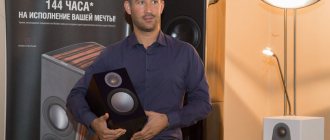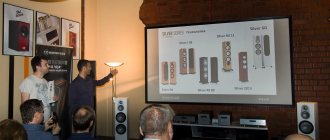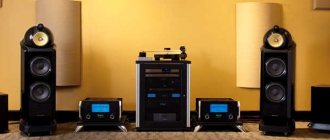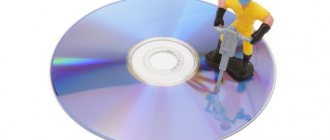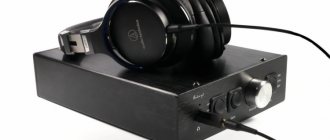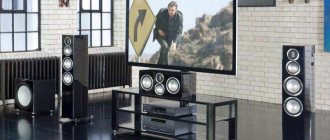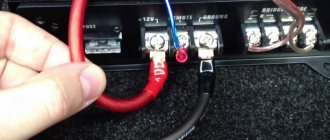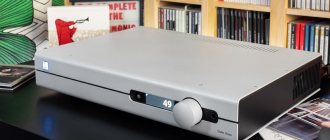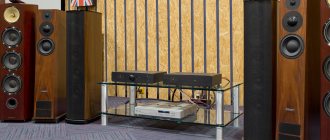Choosing an amplifier for rock music with floorstanding Monitor Audio Silver 300
One thing that I understood from all this is that you personally did NOT like Monitor Audio Silver, and acoustics are what you need to build on when further building your setup. You shouldn’t deceive yourself either - if you didn’t like it, then you shouldn’t convince yourself otherwise. Perhaps the combination of Denon + Marantz did not reveal all the talents of acoustics (especially for rock), but “a bit harsh” is hardly a complaint against them. Moreover, MA is extremely rarely recommended here (or rather, it is usually customary to dissuade them).
If you liked Bowers & Wilkins 603, then, in fact, why not YES - at least, at least you can start from something in the future choice of speakers. On my own behalf (as the owner) I would also recommend listening to the Wharfedale EVO 4 (for your room, of course, older floor-standing speakers are best - 4.4, but EVO should be caught at a discount, catching 4.4 in the region of 115 TR is quite possible), but the character is slightly “a little dark”, but not tiring (Bowers & Wilkins 600 series seemed good to me on the whole, but in terms of design and external performance, EVO, of course, puts many competitors to shame, and structurally too, this is also important for me), however the amplifier for them is better “brighter” at HF (well, in my understanding).
In terms of strengthening, of course, they recommended options that were much more expensive than the designated budget. Well, if for Bowers & Wilkins 603, or EVO 4.4, or other dim and unsharp acoustics, then I would suggest the Yamaha A-S801 (as I understand, you don’t have the source either, but here in the kit there is a very good DAC - well or A-S701, its complete analogue, but with an “add-on” DAC and 15 thousand rubles cheaper, but the DAC separately will be much more expensive and it’s far from a fact that it’s better). In any case, EVO and Yamaha of this series combine very well (I won’t say that they fully reveal them, but in their amplification budget the combination is a solid “4+”) - any rock/metal, even so compressed and turned up in volume a very heavy rock album, like the new The Bitter Truth (2021) from Evanescence, this combination pulls out perfectly (although it is clearly at the limit of its strength, but I read the reviews - most of them are a mess, the album did not suit them in the end, although, as To me, the album is simply excellent! True, I didn’t torture myself with the mp3 - I downloaded it right away in 24/44). One BUT: EVO with the previous series (AS..00), if you decide to look at used amplification, it’s not very good, I don’t recommend it - a strong emphasis on the upper midrange to the detriment of the HF (with the AS..01 series it’s much better - good balance), and, yes, it’s still better to take a silver-plated cable for the mid-HF section (I just took the most affordable one, since I don’t really believe in cables: Dali Connect SC RM230S) - it will slightly emphasize the HF.
In general, really start with the acoustics - this is the first and most important thing, and then it will be easier to decide on the amplification; the main thing for them is not to spoil and/or aggravate the features of this or that speaker.
Devices >Best Guitar Amplifiers for Metal
Hello dear readers of the Guitar School . In this post, we will try to understand what kind of guitar equipment we need for heavy styles. What is the best guitar amplifier to choose if you play metal?
Let's face it: there are a lot of distortion pedals out there aimed specifically at heavy styles, but if you choose the wrong guitar amp, you'll probably always end up with a better tone than you have. It's like chasing the Holy Grail - chasing the perfect sound. Am I wrong?
So, this post contains the 10 most suitable guitar amps for heavy styles of music. This list of guitar amplifiers is not influenced in any way by brand or popularity.
Only sound quality and suitability for playing metal guitar riffs are considered.
- Bogner Uberschall series 120W
- Engl Powerball II
- Mesa Boogie Triple Rectifier
- Blackstar Series One 100
- Diesel VH4
- Peavey 6505+
- Marshall JVM410H
- Orange Amps Dark Terror
- Hughes & Kettner Coreblade
- EVH 5150 III
In one of the previous posts, we made the TOP 10 most popular guitar combo amplifiers. That top caused quite a lot of controversy, but it is quite truthful, since it was formed based on a survey of guitarists. Many people confuse quality and popularity; both expensive and cheap amplifiers were presented on that list, but this does not make them less or more popular or the “best” in quality of all kinds.
This list is compiled based on statistics on the use of a particular model of guitar amplifier for playing heavy music.
Bogner Uberschall series 120W
This guitar amp has truly metallic tones that are controlled primarily by the mids. If you play in lower tunings, such as B or B#, this is the amp for you.
Amplifier characteristics: - Each channel has independent ones - Volume, Gain, Bass, Treble, Middle, & Presence. — Tube buffer on the effects loop, with mute. — General master volume. — Foot controller with channel switching and effects loop. — Two channels with fiber optic illumination. — Line output. — Power 120 watts, EL34 lamps.
Used by the largest number of guitarists playing in a wide variety of styles of metal. If you have problems with the compatibility of the head and acoustics, the best option would be to use Uberschall 4x12 acoustics.
Approximate price: 90,000 rub.
To the list of guitar amplifiers
Engl Powerball II
For maximum versatility in heavy styles, it will be hard for anyone to beat the Engl Powerball II guitar amplifier. It has one clean channel, crunch, and two distortion channels. This guitar amp is the favorite of guitarists such as Jeff Loomis and Glenn Tipton.
The range of features makes the Powerball II attractive to most heavy-duty guitarists. These features make it ideal for the stage. The Powerball II also lacks an impedance switch.
Since this guitar amp has two distortion channels, it is used for rhythm and lead respectively.
To the list of guitar amplifiers
Mesa Boogie Triple Rectifier
Perhaps no list of top metal amplifiers would be complete without the Mesa Boogie Triple Rectifier. It is the most popular and quoted guitar amp among heavy guitarists.
The Mesa Boogie Triple Rectifier has three completely independent channels with eight modes, allowing you to create many different shades of clean and distorted sound. And this mesa really does better than other amplifiers.
The Triple Rectifier places a special emphasis on the rhythm guitar sound. Its powerful third channel provides maximum sound density, making this amp a favorite of guitarists who press the strings at the bridge and generally play PM.
This amp is designed and manufactured in California and is highly regarded by guitarists. By the way, the band Cannibal Corpse uses exactly these amplifiers.
Approximate price: 60,000 rub.
To the list of guitar amplifiers
Blackstar Series One 100
Blackstar only opened their own stores in 2004, but they have nearly 50 years of experience in guitar amp design and construction. And it really shows in their finished products.
Blackstar quickly began to progress in the development of amplifiers for a wide variety of styles of heavy metal. These amps are used by Gus G, Richie Sambora, Ihsahn and James Williamson.
Series One 100 has two channels, two modes each. The clean channel has warm and bright modes, the latter ideal for clean parts, a la Master of Puppets.
The overdrive channel gives us two modes: crunch and super crunch, which lets us know by its name about the nature of its sound.
To the list of guitar amplifiers
Diesel VH4
Since 1994, Diezel VH4 has been manufactured in Germany for artists in styles such as hard rock and metal. Ideal for those who want to emulate the sound of Angus Young's late period guitar.
Unfortunately the Diezel trademark is dying. Let's hope this is a fall before a big rise. This is a business, but the Diezel VH4 is a really worthwhile product.
To the list of guitar amplifiers
In this post, we've only looked at half of the guitar amps that are great for playing heavy styles. In the next post we will look at the list to the end. To avoid missing the next issue, sign up for the free newsletter.
TOP dozen guitar amps for beginners.
As I have already said in previous materials, a significant, and even, if we are not afraid to say, the main role in the sound of an electric guitar is played by where it is plugged in, that is, a guitar amplifier with a speaker (acoustic cabinet) or a combo. It is thanks to the difference in the sound of similar guitars in different amplifiers that so many styles and trends have arisen in modern music. Moreover, I will mention once again the fact that a cheap guitar will sound good, or let’s say, tolerably, in a good amplifier, but even the most expensive instrument will sound disgusting in a cheap, lousy amp. Therefore, you should not succumb to the mistaken opinion that it is better to spend maximum money on a guitar, and already buy a amp for change. The instrument must be, above all, convenient, and the amplifier must be practical.
At first glance, choosing an inexpensive but practical combo seems like a very difficult task. Actually this is not true. Those who want to really learn how to play the electric guitar well in order to become a musician playing in a band, and not a couch guitarist capable of nothing more than YouTube streams, should opt for analog products as their first or even second guitar amplifier.
Playing the guitar is like riding a motorcycle, and before you get behind the wheel of a motorcycle, you must first master the bike, learn how to keep your balance, start and stop, and take turns. Likewise, a home transistor amp is like a bicycle. In this regard, a digital combo can only be compared with an electric scooter. It is quite suitable as a means of transportation, but it will not be possible to switch from it to a motorcycle without knowing how to ride a bicycle.
I'm not saying that digital amplifiers are bad. Very good indeed. But they are good for those who either already know how to play the guitar, or for those who are not going to learn to the level to play in a group. In fact, some even wealthy adults carry an electric scooter in the trunk of their car to leave the car in the parking lot and get to their office or home by the yards, not just hipsters.
Since, unlike the guitar itself, the amplifier is a technically complex device, in order not to make a mistake in choosing, you should opt for branded items. Each brand values its reputation and is responsible for the quality of its products. In addition, each brand provides wholesale and retail suppliers with support, both technical documentation and spare parts, so that if something breaks, there is a better chance of fixing it than with no-name products (products of unknown origin). “Noname” is good in this matter only when it comes to exclusive boutique items, and not to mass consumer goods.
If 10 years ago the choice of home transistor amps in music stores was such that one’s eyes would run wild, today there are not many interesting and worthy options being produced. The choice is not great both here and abroad. Some manufacturers, like Fender and Vox, got carried away with the newfangled digital modeling, while others abandoned the mass market, returning to an expensive and elite lamp. Still others, like Crate, or, to some extent, Trace Elliot, ceased to exist altogether (the latter, after a series of resales and changes of owners, had their model range reduced to a couple of bass models). Nowadays, transistor home amps are becoming an endangered species, and this is very sad. They are being replaced by digital modeling amps and amps.
Among guitar amplifiers, as well as in rock music, several directions have emerged: American, British and German. Scandinavian metal, which stands out separately, can be stylistically attributed to the German direction of music, at least in terms of sound. But, since German manufacturers cannot find budget amplifier models, everything can be roughly reduced to American and British ones. This arose historically due to the fact that when guitar amplification was just developing, some components were popular in one part of the world, and completely different ones in another. In particular, regarding lamps and speakers. All this led to the recognition of American and British sound. Most manufacturers in one or another part of the world correspond geographically to the character of the sound, although on the market you can find American amplifiers with a British sound and vice versa. In their budget home transistor models, each brand manufacturer tries to stick to the sound that matches the style on which the company made its name. Those who try to achieve versatility and sound for every taste, in all styles, do not last in this business. If the manufacturer does not have his own face, no one will remember him. Let's go over what the leading manufacturers of home transistor amps can offer us, and select the most suitable candidates. I will offer half a dozen of the most interesting, in my opinion, home transistor amps, and as a bonus, several options that have already been discontinued, but are still found in stores, since the manufacturers made them with a reserve.
We can say that it was thanks to this American company that guitar amps became the way we know them. Before that, they resembled my great-grandmother’s radio. Many of Leo Fender's innovations were ahead of their time, such as the Presence regulator. Like all geniuses, Leo Fender was a strange man. He called the vibrato lever on a guitar tremolo, the tremolo effect in an amplifier - vibrato, and for some reason he called the brightness control presence (the same Presence). Although this can be explained. By the mid-fifties, Leo began to gradually lose his hearing, and this primarily affected the high frequencies. He even mistakenly called twill tweed, although in fact tweed is a coarse woolen fabric. Fender amps are associated with blues, country, and rockabilly, and are famous for their clean tone and expressive, elastic crunch.
However, today this legendary company, in terms of amplification, cannot offer anything to novice guitarists. What modern Fender marketers are thinking is a mystery to me. How else can you explain the fact that they discontinued the wonderful Fender Frontman 15G amp. Fortunately, it can still be found in stores, and if your music is blues or rockabilly, then this may well be your choice. The only home transistor model left in production, the Fender Frontman 10G, with a six-inch fart, might be interesting if it were battery-powered. The manufacturer even sacrificed the volume knob for the overdrive channel on the ten-watt model, either to reduce the cost, or to fit it into a more compact case.
Vox is the voice of the British Invasion, from the early '60s to the present day. Shadows, Beatles, Rolling Stones, Kinks, Yardbirds, Queen, Dire Straits, U2, Radiohead... The sound of these groups is primarily associated with Vox, although many of them used other amplifiers in their work. But like their Fender competitors in the home guitar amp space, Vox has focused on digital, and has discontinued the 15-watt Vox Pathfinder 15, which features a tremolo and spring reverb (on the R version), and even a two-button footswitch, not a bad thing. for those who are learning to play music from surf in the style of Shadows to not too heavy rock.
The ten-watt version that can now be found in stores does not have any of this. As with Fender, the manufacturer abandoned the overdrive channel volume knob, leaving one common gain for both channels. As with the Fender, the Vox Patfinder 10 is equipped not with an eight-inch speaker, but with a worthless six-inch.
Jim Marshall's amplifiers are associated with all the classic rock and metal of the '70s and '80s. They are what is primarily meant by the term “British sound”. For beginning guitarists, Marshall can offer the MG15 15-watt eight-inch house amp in a closed cabinet (a couple of words were said about the influence of the design in previous materials), or its version with reverb MG15R
Both amps have two channels, clean and overdrive, with separate gain and volume controls. The equalizer is three-band, common to both channels. There is an aux for connecting an external soundtrack source and a headphone output. Both are on minijacks. The standard speaker is an eight-ohm one, albeit a no-name one, but still a guitar one, and quite good.
Orange guitar amplifiers are another British legend. Despite their prim appearance, the amplifiers are distinguished by a dirty, fuzzed, hooligan distortion sound with a large supply of gain, and a crystal clear wedge. For beginning guitarists, Orange offers the Crush 20 20-watt, eight-inch closed-back home amp, or the Crush 20RT version with reverb and built-in tuner. Both amps are two-channel, the overdrive channel has separate gain and volume controls. Channel switching can be done not only with a button, but also with a pedal footswitch. The equalizer is three-band, common to both channels. There is an aux on a minijack for connecting an external source of phonogram and an output on a large 1/4″ headphone jack, and it is cabinetized, that is, simulating the sound of a speaker. I'm very pleased with the funny pictograms instead of labels for sockets, buttons, controls and light bulbs.
I won’t say anything about the stock speaker, but the 35-watt model has a four-ohm speaker. Although I think that in the twenty-watt circuit the circuit is the same, with the exception of the gap, and the speaker is eight-ohm. Why am I paying attention to this? Many guitarists are interested in upgrading guitar pickups and speakers in amps. And very often inexpensive amps use speakers that are not at all designed for use with a guitar. In the case of replacing a four-ohm speaker with an eight-ohm one, the power of the transistor amplifier should theoretically drop by almost half. However, it is not a fact that the amp will sound quieter. Firstly, for the volume to be halved, the power must drop 10 times. And secondly, the volume directly depends on the sensitivity of the speaker. For guitars it is about 100 dB, and it is not known what kind of speaker they can supply at a Chinese OEM factory. Although I repeat once again, I don’t know what the speaker is specifically in this model, it sounds quite decent, and I’m giving information about the ohm capacity in case it’s easier to choose a replacement if desired.
Peavey is another representative of the American school. From the very beginning, Hartley Peavy's slogan was "quality equipment at a reasonable price." The company is a pioneer in the field of inexpensive home amplifiers, introducing transistor amplifiers that emulate the sound of a tube in the early eighties: Decade and Backstage, although in the field of professional tube equipment Peavey enjoys well-deserved respect, although this is more the merit of the legendary engineer James Brown. An example is the legendary model 5150 and many others. For beginning guitarists, Peavey offers an inexpensive 15-watt Peavey 158 home amp with an eight-inch speaker.
The combi is two-channel. The cabinet design is open. The speaker is an 8-ohm Blue Marvel, that is, a guitar one and quite decent. The clean channel is fenderoid, and the overdrive offers 2 “overdrive” options, vintage ala AC/DC and modern metal. On board there is an aux for an external phonogram source and a headphone output, both on large 1/4″ jacks.
The American brand Kustom appeared on the music scene in the mid-sixties. These were the transistor amplifiers and huge cabinets of Bud Ross, received with a bang by rhythm and blues, Motown, surf and rockabilly musicians for their loud and clear sound. Kustom amplifiers also stood out for their design, particularly the "blown" upholstery made of colored faux leather, like the interior of American fast cars. However, modern Kustoms are a completely different story. In the early seventies, Bud sold his company and opened a new Ross, known for iconic guitar gadgets, and then completely gave up music, going into avionics and the production of police radars. In the mid-nineties, the next owners of the brand name revived the production of guitar amplifiers, and achieved success specifically in the field of products for beginning guitarists, although serious cool tube amplifiers were also produced under the Kustom brand in the first decade of the 2000s, when the above-mentioned James Brown worked there. It was at his instigation that Kustom proved that a home amp does not have to be small, and released an inexpensive transistor amp with a full 12-inch speaker. The 12″ speaker in such a combo is good not so much for the sound, but because it makes you feel the feedback of the amplifier, and teaches a novice guitarist how to interact with a real guitar combo.
Today Kustom offers beginner guitarists a 20-watt 12-inch open-design KG112FX amp. The amp is two-channel, with a dense, elastic, clean sound and marshaloid overdrive, with very good legible lows. The overdrive channel has separate gain and volume controls, the equalizer is common to both channels, three-band. In addition, there is delay/reverb, aux and headphone output on board, both on minijacks. The speaker is eight-ohm, and the amp is easily upgradeable. When replaced with a branded guitar speaker, the amplifier begins to sound quite grown-up, although it sounds quite decent with the original one.
Another British legend, the sound of whose amplifiers is associated with The Who, Pink Floyd, Slade, Jethro Tull, Kinks and many others. For beginner guitarists, Hiwatt produces the Crunch series of home tube amplifiers (previously called Maxwatt), which includes 15 and 25-watt models with 8″ speakers. The Fifteen is not so interesting, it does not have full two channels, the gain is common for clean and overdrive, but the twenty deserves attention.
The Hiwatt Crunch 25 is an inexpensive two-channel transistor amp with a fat, warm clean sound, and a very specific old-school fuzzed-out dirty overdrive that takes you straight back to the seventies. A kind of time machine, not in the sense of a musical group, but in the sense of a means of transportation. The equalization for the clean and dirty channels is separate; on the wedge it is the usual three-band equalizer, and on the overdrive there is a Contour knob that cuts out the middle. Gain and volume adjustments for the overdrive channel are separate; a footswitch is provided to switch channels. There is an output for an additional cabinet, an aux for an external phonogram source and a headphone output. Both are on minijacks. The cabinet design is open. The original speaker is four-ohm. A version with a spring reverb on board is also produced.
Laney is another representative of the British school. Its history dates back to the late sixties. In the seventies, Lyndon Laney's amplifiers enjoyed mostly local success in their homeland, England, but even then they were played by Black Sabbath's Tony Iommi, who is loyal to this brand to this day. In the eighties, they triumphantly broke into the American market, thanks to high-gain amplifiers, loved by metalheads and shredders. For beginning guitarists, Laney produces a pair of twenty-watt home transistor amps, the LX20R and LG20R.
At first glance, both of them are the same, and differ only in design. The first has a metal grille and handles facing forward, the second is in a more vintage style, with handles sticking up. However, in sound they are radically different. The first with a very sharp wedge and an overdrive that is too sandy (for my subjective taste), the second with a much fatter clean channel and a more melodious overdrive. The overload on both one and the other is moderately high gain. The design of the cabinet is open, but LG probably even fits the definition of semi-open, since it has a much larger rear wall area. The speaker is eight-ohm HH. The overdrive channel has separate gain and volume controls. The equalizer is three-band, common to both channels. There is a reverb on board. The amp is equipped with an aux for connecting an external phonogram source and a headphone output. Both are on large quarter-inch jacks.
An associate of the aforementioned Leo Fender, Don Randall, left the company in the late sixties, after briefly working for Fender's new owners, CBS. In the early seventies, he opened his own company under his own name. Randall were famous for their high-gain transistor amplifiers in the eighties, but this was not due to Don, but to his partner and engineer Gary Sanda. Randall is one of the few transistor amplifiers that has been embraced by rockers and metalheads. Guitarists from Pantera, Deff Leppard, Journey, Dokken, Kiss, Poison, Winger, Dio, Sami Hagara, Michael Batio and even Kurt Cobain played transistor Randalls. Under the new owners, the company also produces tube amplifiers, which, among other things, can be found in the arsenal of Metallica and Anthrax. Until recently, for beginning guitarists, Randall produced the RX25RM home transistor amp, which can still be found in stores, with an eight-inch speaker in a closed cabinet. R here means the presence of a spring reverb, M - a metal grille that protects the speaker and a dark chrome finish (if you also see BC after the letter M, this is the dark chrome version). There were also versions with the index D instead of R, with digital effects, chorus, flanger, phaser, tremolo, delay, reverb, but this is already superfluous. The Randall RX25RM amp is a two-channel, clean and overdrive amp, with the ability to switch channels from a footswitch. The overdrive channel has separate gain and volume controls, and there is also an additional booster heating pad. In addition, there is also a master volume for both channels, which is undoubtedly a huge plus. Three-band equalizer, common to both channels. There is an aux for the phonogram source, on a pair of separate RCA tulips, and a headphone output on a large 1/4″ jack. The speaker is eight ohm.
The RX25M has now been discontinued, leaving only the 15-watt six-inch version. True, there are also several signature models of Nuno Bettencourt, Kirk Hammett, and George Lynch, but again they are six-inch, so they are of interest only to fans of Metallica and Extreme as a cult of worship.
I would also like to mention the very worthy home transistor amps Crate, but the brand was liquidated so long ago that now they can only be found on the secondary market, in used condition.
Before switching from a bicycle to a heavy bike, you should first master a small-capacity one. Learn to control it, taking turns not by turning the steering wheel, but by moving the center of gravity and tilting the motorcycle and using the throttle. The same applies to playing the guitar, where a low-power tube amp plays the role of some kind of ebrik (a light Yamaha YBR-125 motorcycle), and the role of controlling the center of gravity and the throttle handle is the inclination and depth of immersion of the pick.
There is an opinion that buying and operating a tube amplifier is an expensive pleasure. Yes this is true. The production of tube amplifiers involves a lot of manual labor, not only from the people who solder them, but also from those who set them up. And the lamps themselves are consumables; they require replacement from time to time, and their prices are steep. Nevertheless, I will try to offer about five decent tube guitar amps that won’t hit your pocket too hard.
The Chinese manufacturer Joyo from Shenzhen is known not only for clones of popular devices, but also for its own developments, in particular the very cool and advanced DualKlonz guitar head. Interestingly, the Joyo and Mooer brands belong to the same family and are produced in the same factory. Joyo is for the husband, and Mooer is for the wife. This is probably why the design of Mooer cases is so elegant, and Mooer is so brutal.
The Joyo JTA-05 Sweet Baby tube guitar amp is a clone of the legendary vintage Fender Champ amp from 1957. Originally supplied with a lap steel guitar, the original Fender Champ quickly won the love of American black bluesmen for its melodious clean crunch and ability to sound equally good both quietly, in the tenement ghettos of Chicago's West Side, where electric blues originated, and quite loudly. to perform in small clubs and bars.
JTA-05 Sweet Baby is an ideal option for home practice. It allows you to hone one of the most important skills - controlling dynamics with your fingertips, which is impossible to master on any transistor, and even more so on a digital amp or processor. After all, one of the most unpleasant disappointments of a guitarist is when, having achieved, at first glance, significant success by playing digitally, he finally finds himself in an expensive studio with a real vintage device, and is unable to play a single usable note due to the lack of dynamics control. The functionality of the Joyo JTA-05 Sweet Baby is simple and minimalistic, just one volume knob and that’s it, but the amp is compatible with guitar pedals and can be accelerated perfectly with heating pads. In addition, the tube rectifier is a great experience to get a feel for the behavior of vintage amplifiers and that very Sag. Amplifier power - 5W. The Sweet Baby amp is equipped with a proprietary Eminence EGTR-S108 eight-inch guitar speaker
Bugera is a subsidiary of Music Tribe, founded by a savvy Swiss entrepreneur named Uli Beringa.
The company is positioned as German, but for tax evasion it is registered offshore in the British Virgin Islands. Nevertheless, Uli managed to acquire ownership of factories, newspapers, and ships in communist China. Uli has a bad reputation among music equipment manufacturers. Some consider him an upstart, others a plagiarist. Nevertheless, the Behringer business (the brand name is pronounced in the English manner as Beringer) is very successful, and at the same time legally clean, and his company bought up such brands as Midas, KlarkTeknik, Turbosound, tcelectronic, ColorAudio, Aston Microphones, Tannoy. He even had a chance to buy Gibson, which was teetering on the brink of bankruptcy, but was prevented almost by the personal intervention of Donald Trump, at that time the President of the United States. Under the Bugera brand name, Music Tribe manufactures guitar amplifiers.
The Bugera V5 Infinium tube guitar amp is considered by many to be a clone of the Matchless SC Mini, but this is a mistaken opinion; the only thing they have in common is their appearance. The V5 Infinium is Bugera's own development. The combo is very simple, but works great with guitar pedals. Power - 5 Watt. Its own sound has a British character ala vox. Unlike most other tube amps in this price class, the Bugera V5 Infinium is quite sophisticated. There are independent gain and volume controls, tone control, and reverb. True, the reverb is digital, but it works in parallel; the main signal path is entirely tube-based. There is also an attenuator that allows you to make the amp sound very quiet at home volume. There are also outputs to an external cabinet and to headphones, and not from the preamp, but from the tip. The speaker is an eight-inch Turbosound, but four-ohm, keep that in mind if you decide to replace it. Although you can be completely satisfied with it. Another interesting solution is a light, like a Check Engine light, that signals when it's time to change the bulbs.
Yerasov is a domestic manufacturer of guitar amplifiers and effects, one of the few that have managed to establish mass rather than boutique production. Unfortunately, not so long ago, Alexander Evgenievich Erasov left us, but the company is confidently staying afloat, under the leadership of his son. What is worth noting is that Alexander Evgenievich always listened to the buyer’s opinion and actively participated in the discussion of what guitarists want. This is how his popular tube amplifier Gavroche was born.
Yerasov Gavrosh 8 is a tube guitar amp designed for home practice. The manufacturer positions it as a device for home exercises using pure sound or with gadgets. In a sense, this combo can be called an anti-fender. If Leo Fender added a Presence knob to his amplifiers, which adds brightness, then Erasov installed a filter that cuts off excess sand from overdrive-distortion gadgets. The tone block has treble and bass controls. Another Gavroche feature is a passive load, which allows you to play in silence through headphones without disconnecting the terminal, extinguishing the signal destined for the speaker through a load resistor. You don't bypass the tip, allowing you to fully use it with headphones. The manufacturer offers a choice of eight-inch Celestion or Jensen guitar speakers and upholstery color to suit the customer’s taste.
I have already talked about the British manufacturer Laney above. The Laney Cub 8 guitar combo is as simple and primitive as the Joyo mentioned above. In essence, this is the same champ, although not as “honest” as Joyo JTA-05. But there is at least some kind of tone control at hand.
Amplifier power – 5W. Speaker – Celestion Super 8.
The American brand VHT is associated with cool boutique amplifiers. However, since 2009, this brand has nothing to do with the same VHT, now produced under the Fryette brand name. The brand name was sold to AXL, a company specializing in mass market products. However, AXL produces very decent inexpensive amplifiers under the VHT brand, both modeling and tube.
The VHT Special 6 is very similar to the Laney Cub 8, but much more interesting. Firstly, there is switching the power of the tip, and secondly, there is a built-in booster that accelerates overload, and it can be activated not only from the control panel of the push-pull gain knob, but also from the footswitch. The amplifier goes well with external pedals. And thanks to the use of hinged mounting (Handwired), it can easily be modernized, which opens up a wide field of activity for those who are comfortable with a soldering iron. In addition, the amp is equipped with a larger ten-inch speaker, which is a huge plus. In addition, VHT Special 6 is produced as a separate head.
These, of course, are not all the options that can be found in stores, but I tried to highlight those that can be purchased at a not too steep price. In Skifmusic stores you will always find a selection of decent guitar combos. But don’t rely too much on advice, even mine. Just come to the store, listen to everything with your ears, touch it with your hands and make the right choice.
Author – Sergey Ivanov
